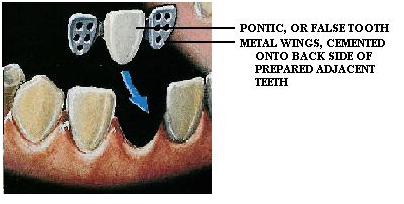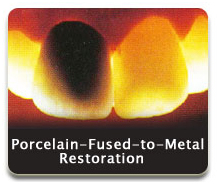CROWN & BRIDGE
CROWNS:

Crowns become necessary when there is insufficient tooth structure to support a filling. Teeth that are severely broken down from decay or fracture can be fully restored to proper appearance and function with a crown restoration. If you are missing one or more natural teeth, then you know how much this diminishes
your chewing ability. What you may not realize is that missing teeth also affect your facial structure, increasing stress on remaining teeth and often giving your cheeks a sunken appearance .BRIDGES:


Both crowns and most bridges are fixed prosthetic devices. Unlike removable devices such as dentures, which you can take out and clean daily, crowns and bridges are cemented onto existing teeth or implants, and can only be
removed by a dentist If you are missing one or more natural teeth, then you know how much this diminishes your chewing ability. What you may not realize is that missing teeth also affect your facial structure, increasing stress on remaining teeth and often giving your cheeks a sunken appearance . removed by a dentist Crowns become necessary when there is insufficient tooth structure to support a filling. Teeth that are severely broken down from decay or fracture can be fully restored to proper appearance and function with a crown restoration.WHAT ARE DENTAL CROWNS AND TOOTH BRIDGES?
Bridgework works like a series of connected crowns, replacing missing teeth by bridging the gap and using the surrounding teeth as abutments. If you are missing one or more natural teeth, then you know how much this diminishes your chewing ability. What you may not realize is that missing teeth also affect your facial structure, increasing stress on remaining teeth and often giving your cheeks a sunken appearance .HOW DO CROWNS WORK?
A crown is used to entirely cover or “cap” a damaged tooth. Besides strengthening a damaged tooth, a crown can be used to improve its appearance, shape or alignment. A crown can also be placed on top of an implant to provide a tooth-like shape and structure for function. Porcelain or ceramic crowns can be matched to the color of your natural teeth. Other materials include gold and metal alloys, acrylic and ceramic. These alloys are generally stronger than porcelain and may be recommended for back teeth. Porcelain bonded to a metal shell is often used because it is both strong and attractive. Your dentist may recommend a crown to:- Replace a large filling when there isn’t enough tooth remaining
- Protect a weak tooth from fracturing
- Restore a fractured tooth
- Attach a bridge
- Cover a dental implant
- Cover a discolored or poorly shaped tooth
- Cover a tooth that has had root canal treatment
HOW DO BRIDGES WORK?
A bridge may be recommended if you’re missing one or more teeth. Gaps left by missing teeth eventually cause the remaining teeth to rotate or shift into the empty spaces, resulting in a bad bite. The imbalance caused by missing teeth can also lead to gum disease and temporomandibular joint (TMJ) disorders. Bridges are commonly used to replace one or more missing teeth. They span the space where the teeth are missing. Bridges are cemented to the natural teeth or implants surrounding the empty space. These teeth, called abutments, serve as anchors for the bridge. A replacement tooth, called a pontic, is attached to the crowns that cover the abutments. As with crowns, you have a choice of materials for bridges. Your dentist can help you decide which to use, based on the location of the missing tooth (or teeth), its function, aesthetic considerations and cost. Porcelain or ceramic bridges can be matched to the color of your natural teeth.HOW ARE CROWNS AND BRIDGES MADE?
Before either a crown or a bridge can be made, the tooth (or teeth) must be reduced in size so that the crown or bridge will fit over it properly. After reducing the tooth/teeth, your dentist will take an impression to provide an exact mold for the crown or bridge. If porcelain is to be used, your dentist will determine the correct shade for the crown or bridge to match the color of your existing teeth. Using this impression, a dental lab then makes your crown or bridge, in the material your dentist specifies. A temporary crown or bridge will be put in place to cover the prepared tooth while the permanent crown or bridge is being made. When the permanent crown or bridge is ready, the temporary crown or bridge is removed, and the new crown or bridge is cemented over your prepared tooth or teeth.HOW LONG DO CROWNS AND BRIDGES LAST?
To prevent damage to your new crown or bridge, avoid chewing hard foods, ice or other hard objects. Crowns Full porcelain fused to metal.
Full porcelain fused to metal.
 Teeth around the space are prepared.
Teeth around the space are prepared. The bridge is mounted and adjusted for fit and comfort
The bridge is mounted and adjusted for fit and comfort The bridge is cemented into position
The bridge is cemented into positionMARYLAND BRIDGE
The Maryland dental bridge is one of a few types of bridges used to replace teeth. Named for the University of Maryland, where it was developed, this bridge is resin-retained and commonly used to replace the front teeth. A pontic (false tooth) is attached to metal bands that are hidden with a white-colored composite resin and attached to the back sides of the teeth on either side of pontic.
OTHER TYPES OF BRIDGES
Conventional fixed bridge —with this most commonly used bridge, teeth on both sides of the missing tooth must be trimmed. A porcelain crown is then placed on top of each tooth. A single false tooth (pontic) is bonded to the middle, creating a bridge between the teeth. Cantilever bridge —A common version of this is the 3-unit cantilever bridge. Two abutment crowns are placed side by side on the same side of the space created by the missing tooth.AN ADVANTAGE OF THE MARYLAND BRIDGE
Supporting teeth are hardly affected by a Maryland bridge. They are not trimmed down, nor does a dentist fit these teeth for crowns.DISADVANTAGES
There are two aesthetic problems with a Maryland bridge. The metal bands attached to the backside of the front teeth may cause those teeth to become a bit darker than or different in color from the rest of the teeth. A pontic made of porcelain, which is common, will be slightly lighter in color than the natural teeth. To match the color of natural teeth, the pontic should be made of a translucent material.PROCEDURE
Placement of a dental bridge requires two trips to the dentist’s office. During your first visit, your dentist will want to ensure that you do not feel any pain throughout the procedure. He or she will administer a local anesthetic to keep you as comfortable and pain-free as possible. Next, an impression of your mouth will be taken. This will allow your dentist to see what your teeth look like before you receive your new bridge. Your permanent bridge will not be ready right away, so your dentist will fit you with a temporary bridge instead. This temporary bridge is weaker (and not made of porcelain) and will easily be removed during your next trip to the dentist’s office. Before your permanent bridge is placed in your mouth, you will have a chance to see what it looks like and how it feels when you visit the dentist the second time. When you are certain that it looks and feel the way you would like, it will be placed permanently in your mouth. Your dentist might want to make some more adjustments to your bridge to make sure that your occlusion (bite) is correct.CARE AND MAINTENANCE
Taking especially good care of your dental bridge is important. The best way to do so is to incorporate good oral hygiene into your daily routine. There are some simple steps you can take to help reduce future oral health problems. Brush your teeth carefully after every meal with fluoride toothpaste and a soft-bristled toothbrush. This is because lodged food can cause your gums and teeth to become infected. (If you do not receive dental attention for the infection, you may experience other problems, which will eventually result in the loss of your bridge.) Properly flossing stops the buildup of food and the dental problems this can cause by cleaning those hard-to-reach places between the bridge and its attached teeth. Properly flossing stops the buildup of food and the dental problems this can cause by cleaning those hard-to-reach places between the bridge and its attached teeth. Because debris left behind from foods high in sugar and starch can turn into harmful acids that may damage the gums and teeth, limiting your intake of such foods is also recommended.CANDIDATES FOR DENTAL BRIDGES
Not everyone is qualified to receive a dental bridge. A dentist is unlikely to recommend a bridge for a patient who does not brush his teeth twice a day and floss regularly and who has tooth decay. Smokers and patients with unstable supporting teeth are also not good candidates for a bridge. A Maryland bridge is a very good choice for a patient who is missing a front tooth and practices good oral hygiene.
As with crowns, you have a choice of materials for bridges.You have them in either metal, metal in overlaid ceramic (porcelain fused to metal) or the latest metal free (all ceramic) crowns. The PFM (porcelain fused to metal) crowns have a metal base coated with ceramic. PFM’s came closer to the look of real teeth and also provided good strength, durability and fit. A drawback of these crowns however could be a black metal line seen along the border of the crown . Also, it is difficult to achieve the translucency of your natural teeth with a restoration that has a metal framework. Light does not pass through the metal base like it does through your own natural teeth, leaving a dull lifeless appearance. On the other hand in metal free ceramic crowns, the metallic look and the black lines disappear.They are not only highly aesthetic but also offer high strength restorations to dental industry. Types of metal free available at our centre
METAL FREE CROWNS
PROCERA :
We offer the new machined / hand laid porcelain technology that is truly strong enough and universally recommended for replacement of old crowns and large silver fillings for your back teeth. This new system called procera, gives you the strength of traditional gold, while maintaining the beauty and translucency of porcelainLAVA :
A lava crown is one of the strongest ceramic crowns available in the world Lava crowns provide excellent aesthetics and translucency besides an outstanding marginal fit. Also each lava restoration comes with a 5 year warranty on the complete crown or bridge. We provide you with a warranty card that has an authentication label with a unique barcode. Using the special barcoded labels you can verify the authenticity of genuine lava on the 3M global website. >



